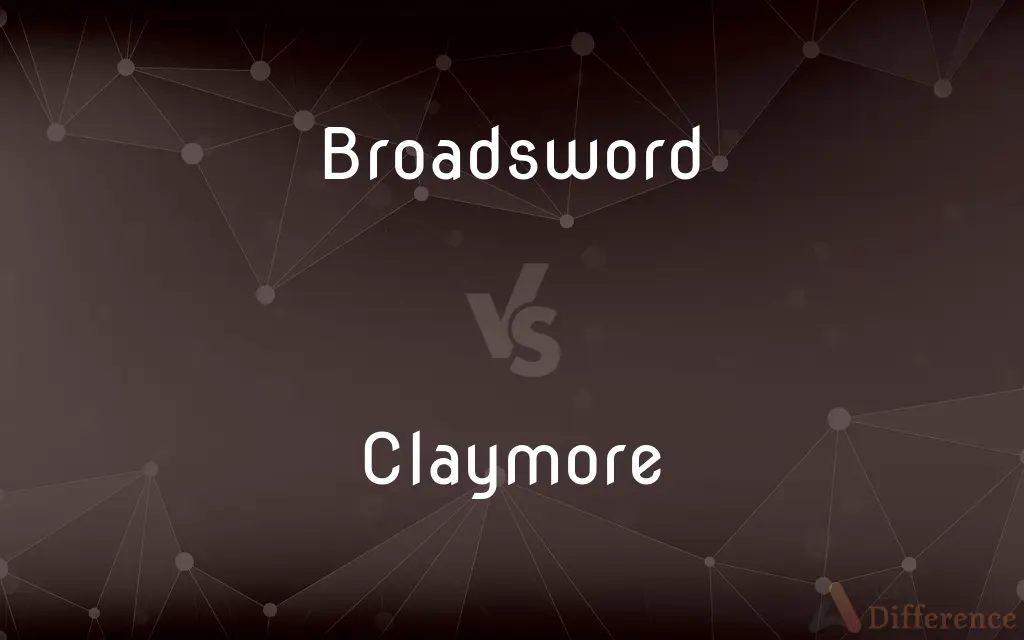Broadsword vs. Claymore — What's the Difference?
Edited by Tayyaba Rehman — By Urooj Arif — Updated on March 27, 2024
Broadsword typically refers to a wide-bladed, one-handed sword, while claymore denotes a large, two-handed Scottish sword.

Difference Between Broadsword and Claymore
Table of Contents
ADVERTISEMENT
Key Differences
Broadswords are characterized by their broad, straight, or slightly curved blades, designed for slashing and chopping rather than thrusting. These swords were commonly used in Europe from the 16th to the 19th centuries, particularly by cavalrymen in battle. In contrast, the claymore is a specific type of large, two-handed sword that originated in Scotland, identifiable by its distinctive cross hilt with downward-angled arms and a large pommel. The term "claymore" historically refers to Scottish swords used from the late 15th to the 17th centuries.
The broadsword's design, including its broad blade and basket hilt (in later versions), provided a balance between offense and defense, allowing for effective use in close combat. The claymore, with its longer blade and two-handed grip, was suited for powerful swings and was often used in open battlefield conditions to break through enemy lines or engage multiple opponents.
In terms of usage, broadswords were versatile weapons that could be used effectively on horseback or on foot, adapting to various combat situations. The claymore's size and weight required the wielder to use both hands, limiting its use to foot soldiers and restricting the wearer's ability to wield a shield effectively. However, its reach and power made it formidable in the hands of a skilled user.
Culturally, both swords hold significant places in history and literature. The broadsword is associated with the military history of several European countries, while the claymore is closely linked to Scottish heritage and identity, often celebrated in folklore, historical reenactments, and modern media.
Despite their differences, both the broadsword and claymore are admired for their craftsmanship, beauty, and the skill required to wield them effectively. They remain popular subjects of study for historians, collectors, and enthusiasts of historical weaponry.
ADVERTISEMENT
Comparison Chart
Blade Design
Broad, straight or slightly curved.
Large, two-handed with distinctive cross hilt.
Usage
One-handed, versatile in combat.
Two-handed, used for powerful swings.
Historical Period
16th to 19th centuries in Europe.
Late 15th to 17th centuries in Scotland.
Combat Style
Suitable for both horseback and foot soldiers.
Primarily used by foot soldiers.
Cultural Significance
Associated with European military history.
Closely linked to Scottish heritage.
Compare with Definitions
Broadsword
Versatile Combat Sword.
The broadsword's design made it ideal for various combat situations.
Claymore
Two-Handed Sword.
He trained rigorously to master the two-handed grip of the claymore.
Broadsword
One-Handed Weapon.
His broadsword was his preferred weapon, even on foot.
Claymore
Battlefield Weapon.
With his claymore, he could engage multiple enemies with sweeping strikes.
Broadsword
Wide-Bladed Sword.
The knight wielded a broadsword with remarkable skill.
Claymore
Large Scottish Sword.
The warrior's claymore was both a weapon and a symbol of his clan.
Broadsword
European Military History.
Broadswords were a common sight in 17th-century European battles.
Claymore
Symbol of Scottish Heritage.
The claymore holds a place of honor in Scottish history and culture.
Broadsword
Basket-Hilted Sword.
The broadsword's basket hilt protected his hand during duels.
Claymore
Distinctive Cross Hilt.
The claymore's cross hilt was adorned with intricate patterns.
Broadsword
A sword with a wide blade, used for cutting rather than thrusting.
Claymore
A claymore (; from Scottish Gaelic: claidheamh-mòr, "great sword") is either the Scottish variant of the late medieval two-handed sword or the Scottish variant of the basket-hilted sword. The former is characterised as having a cross hilt of forward-sloping quillons with quatrefoil terminations and was in use from the 15th to 17th centuries.
Broadsword
A sword with a wide, usually two-edged blade that is designed for slashing rather than thrusting.
Claymore
A broadsword formerly used by Scottish Highlanders, typically double-edged.
Broadsword
(history) A type of early modern sword that has a broad double-edged blade for cutting (as opposed to the more slender thrust-oriented rapier) and typically a basket hilt.
Claymore
A type of anti-personnel mine.
Broadsword
A person armed with such a sword.
Claymore
A claymore mine.
Broadsword
Syn of longsword
Claymore
A large, double-edged broadsword formerly used by Scottish Highlanders.
Broadsword
A flat, rectangular bread made from corn (maize) and beans by the Cherokee, traditionally by boiling rather than baking it.
Claymore
A large two-handed sword historically used by the Scottish Highlanders.
Broadsword
A sword with a broad blade and (usually) two cutting edges; used to cut rather than stab
Claymore
Antipersonnel mine
Claymore
A large two-handed sword used formerly by the Scottish Highlanders.
Claymore
A large double-edged broadsword; formerly used by Scottish Highlanders
Claymore
An anti-personnel land mine whose blast is aimed at the oncoming enemy
Common Curiosities
Can broadswords be used with a shield?
Yes, the one-handed design of broadswords allows for the use of a shield in the other hand.
How did the design of the broadsword evolve over time?
The broadsword evolved to include protective features like the basket hilt, improving the wielder's defense during combat.
Were claymores only used in battles?
Primarily, yes. The claymore's size made it most suitable for open battlefield use, though it also held ceremonial significance.
Were claymores used in any other regions outside of Scotland?
While the claymore is distinctly Scottish, similar types of large, two-handed swords were used in various forms across Europe.
How are broadswords and claymores represented in modern media?
Both swords are popular in films, literature, and video games, often symbolizing heroism and martial prowess.
Why is the claymore associated specifically with Scotland?
The claymore developed in Scotland and was used by Scottish warriors, becoming a symbol of Scottish fighting spirit and heritage.
Can a broadsword be used for thrusting attacks?
While designed primarily for slashing, some broadswords with pointed tips could also be used for thrusting.
What is the main difference between a broadsword and a claymore?
The main difference lies in their design and usage: broadswords are one-handed with a broad blade, while claymores are larger, two-handed swords.
Is the claymore heavier than the broadsword?
Yes, the claymore is generally heavier due to its larger size and two-handed design.
Are broadswords and claymores still made today?
Yes, they are made for ceremonial purposes, historical reenactments, and collectors interested in historical weaponry.
Share Your Discovery

Previous Comparison
Sediment vs. Decantation
Next Comparison
Socialise vs. SocializeAuthor Spotlight
Written by
Urooj ArifUrooj is a skilled content writer at Ask Difference, known for her exceptional ability to simplify complex topics into engaging and informative content. With a passion for research and a flair for clear, concise writing, she consistently delivers articles that resonate with our diverse audience.
Edited by
Tayyaba RehmanTayyaba Rehman is a distinguished writer, currently serving as a primary contributor to askdifference.com. As a researcher in semantics and etymology, Tayyaba's passion for the complexity of languages and their distinctions has found a perfect home on the platform. Tayyaba delves into the intricacies of language, distinguishing between commonly confused words and phrases, thereby providing clarity for readers worldwide.















































